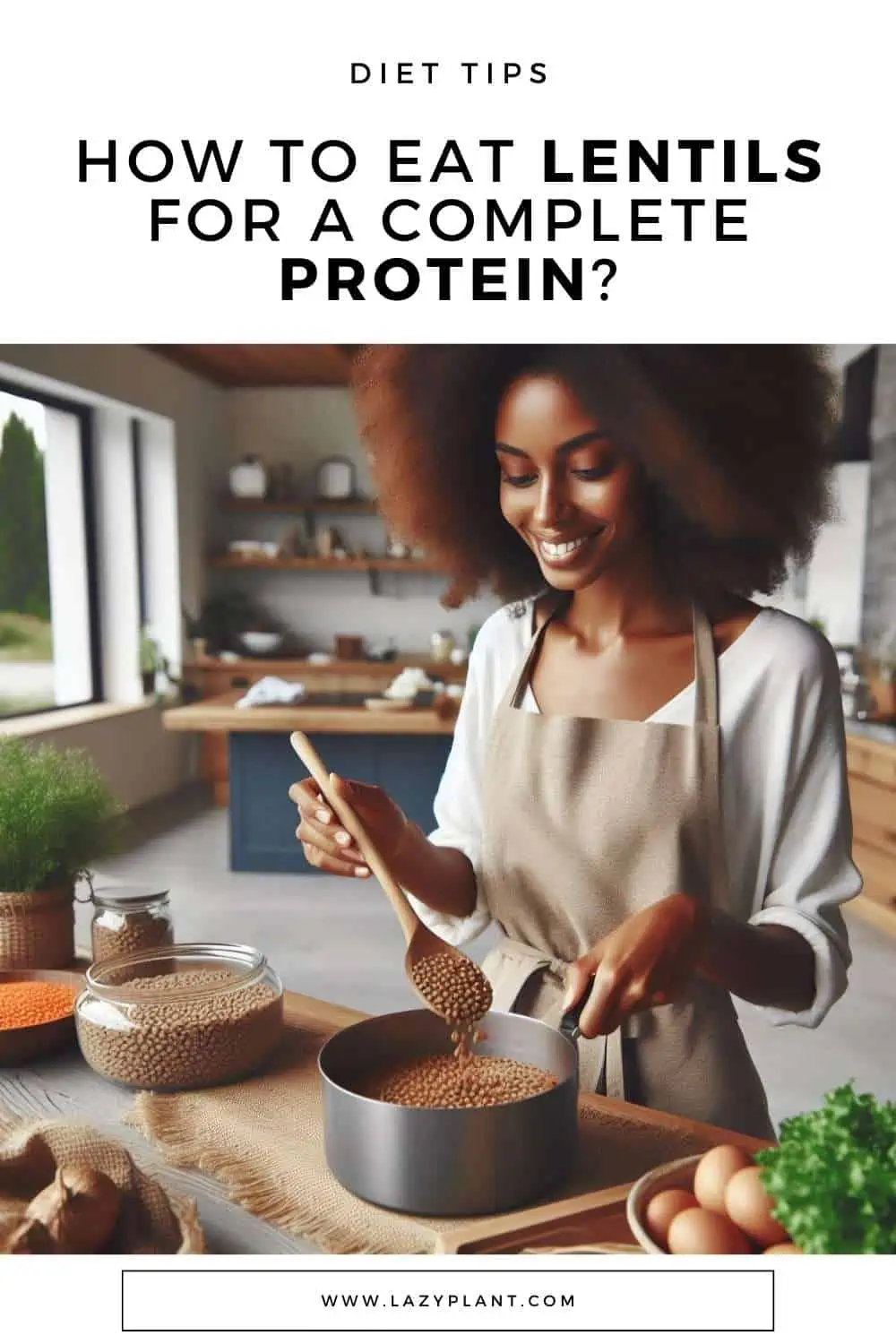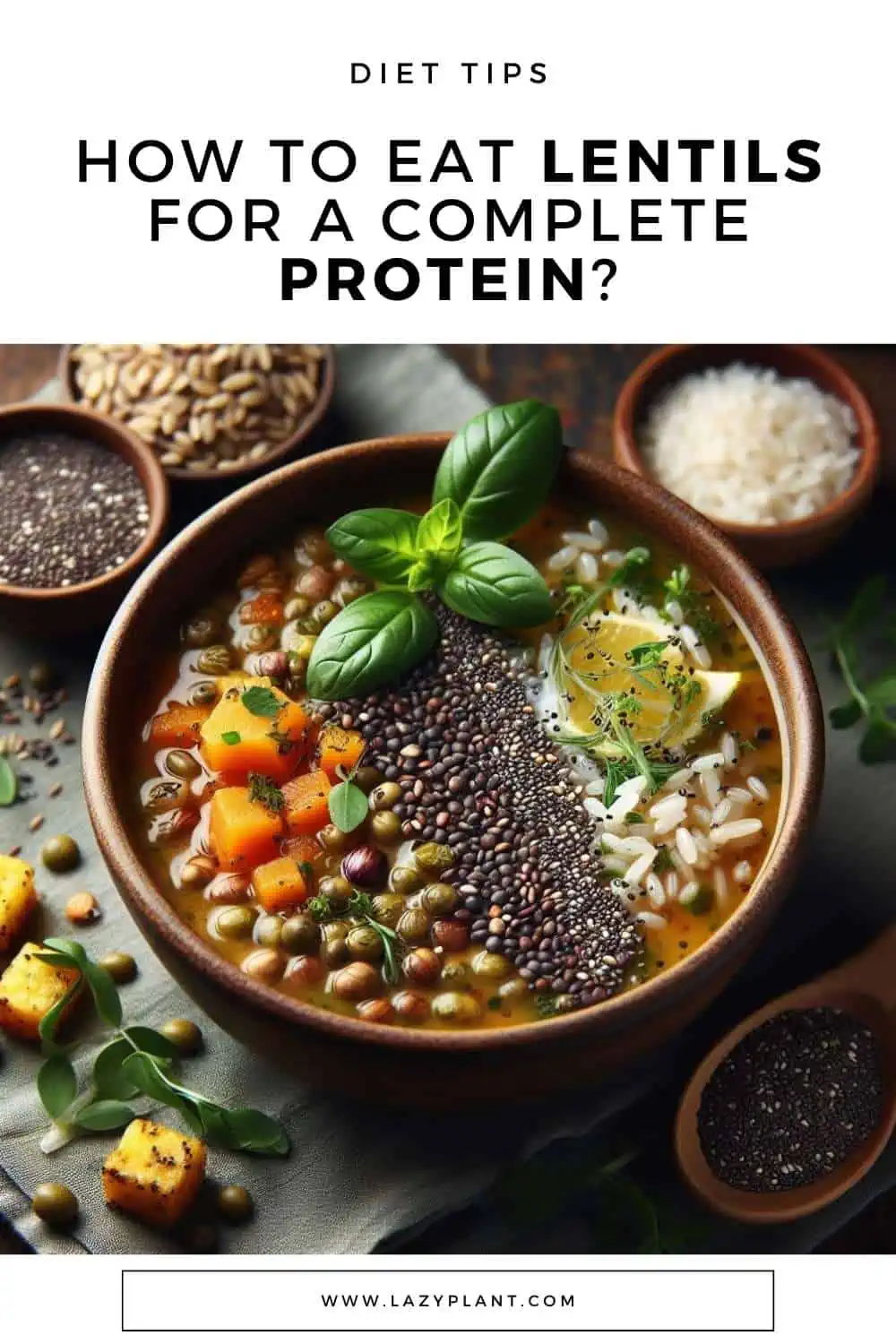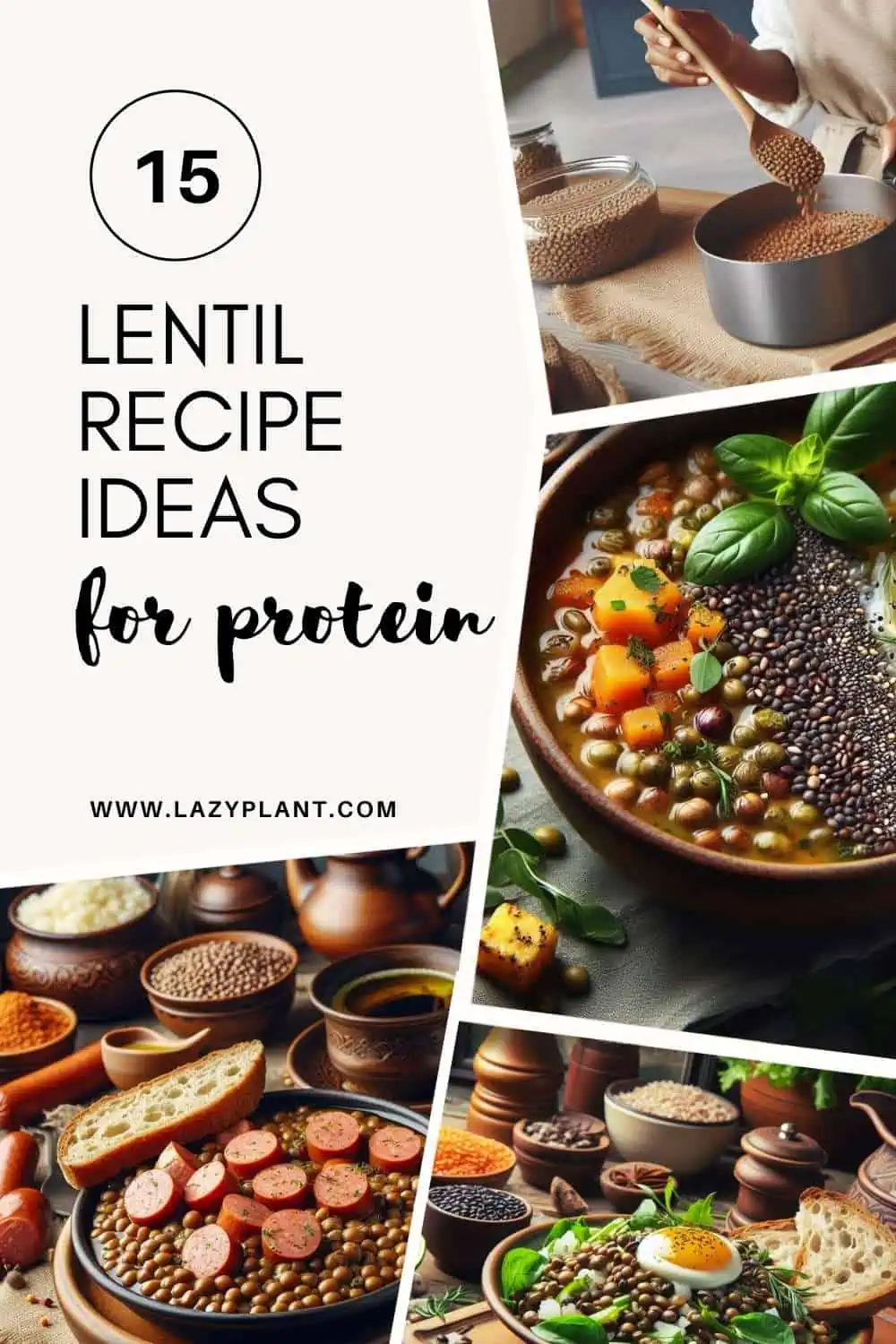Lentils are excellent vegan sources of protein, containing up to 18 grams per cup. But they aren’t a complete protein source, as they lack the essential amino acid methionine! Hence, we should cook lentils with certain vegan or animal foods for a complete, high-quality protein source. You’ll find many healthy meal ideas, suitable for a low-calorie diet plan.
Lentils aren’t a complete protein
Beans and legumes are high in protein. A cup of cooked lentils provides up to 18 grams of protein!
However, they aren’t a complete protein. Proteins are made of amino acids. We have to take 9 essential amino acids from food. The human body can’t synthesize them.
Although raw lentils are about 25% protein, most lentil varieties don’t contain adequate amounts of methionine, which is an essential amino acid.[1]
So, we should combine lentils with foods high in methionine in order to eat a complete protein.
| lentils, cooked 100g | brown rice, cooked 100g | whole-grain wheat flour 100g | |
| calories | 114 | 122 | 332 |
| protein (g) | 9 | 2,73 | 9,6 |
| carbs (g) | 19,5 | 25,4 | 74,5 |
| fiber (g) | 7,9 | 1,6 | 13,1 |
| iron (mg) | 3,3 | 0,56 | 3,7 |
| phosphorus (mg) | 180 | 102 | 323 |
| potassium (mg) | 369 | 86 | 394 |
| zinc (mg) | 1,27 | 0,71 | 2,96 |
| selenium (mcg) | 2,8 | 5,8 | 12,7 |
Which lentil variety is the best protein source?
You should prefer red lentils. They’re richer in protein and they have a better amino profile. Split red lentils are richer in essential amino acids than green lentils.
Both lentil varieties don’t contain adequate amounts of methionine, though.
| green lentils, cooked g/100g | split red lentils, cooked g/100g | |
| Histidine | 0,26 | 0,29 |
| Isoleucine | 0,37 | 0,43 |
| Leucine | 0,78 | 0,91 |
| Lysine | 0,78 | 0,81 |
| Methionine | 0,08 | 0,08 |
| Phenylalanine | 0,51 | 0,60 |
| Threonine | 0,41 | 0,45 |
| Tryptophan | 0,08 | 0,10 |
| Valine | 0,42 | 0,50 |
Combine lentils with rice or cereals for complete protein
Lentils are high in lysine. On the contrary, rice, wheat, and most cereals don’t contain adequate amounts of lysine. Combining lentils with rice and whole-grain bread creates a complete protein.
| brown rice, cooked g/100g | wheat bread g/100g | |
| Histidine | 0,07 | 0,22 |
| Isoleucine | 0,11 | 0,14 |
| Leucine | 0,21 | 0,33 |
| Lysine | 0,10 | 0,18 |
| Methionine | 0,06 | 0,07 |
| Phenylalanine | 0,13 | 0,34 |
| Threonine | 0,10 | 0,18 |
| Tryptophan | 0,03 | 0,16 |
| Valine | 0,15 | 0,07 |
Besides lentils, you could consume other beans, such as chickpeas and fava beans with rice or whole wheat bread to have a meal with high-quality plant-based protein.
Furthermore, you could add nutrient-dense vegetables like kale to your lentil recipes. Kale is among the richest vegetables in protein. However, it lacks of lysine and leucine.

Vegan foods high in methionine
Certainly, even consuming rice with lentils and wheat bread won’t create a high-quality protein. None of these foods is a good source of the essential amino acid methionine.
We should combine lentils with foods high in methionine to make a complete and high-quality protein. Most people need about 10 mg of methionine per kilogram of body weight. Therefore, a 70 kg person requires about 0.7 grams of methionine a day.[5]
Plant-based foods rich in methionine are:[6]
- pumpkin seeds (2.34 g per 100g)
- sesame seeds (1.6 g)
- Brazil nuts (1.1 g)
- hemp seeds (0.9 g)
- soy protein (0.8 g)
- chia seeds (0.6 g)
- oats (0.3 g)
- peanuts (0.3 g)
- buckwheat (0.29 g)
- chickpeas (0.25 g)
Hence, eating bread with sesame or pumpkin seeds with lentils could skyrocket the nutritional value of your meal. Certainly, you could be creative and cook lentils with these seeds.
Just 1 tbsp of pumpkin seeds contains 0.17 g of methionine!
Better cook lentils with chia seeds, instead of rice. They’re particularly high in methionine as well. Also, chia seeds are a complete protein! They contain all 9 essential amino acids. Furthermore, chia seeds are among the best plant-based sources of omega-3s.
Pumpkin seeds are a complete protein as well.
Eat lentils with cereals
Lentils are particularly high in lysine. Lysine is also an essential amino acid. It’s necessary for muscle growth and good metabolism. We need about 30 mg of lysine per kg of body weight. Hence, a 70 kg person needs about 2.1 grams of lysine a day.
Lentils are an excellent source of lysine. Cooked lentils contain about 0.81 grams of lysine per 100g.
On the contrary, most cereals are pretty low in lysine. Therefore, eating lentils with rice, or whole-grain bread, “creates” a complete protein, promoting muscle growth and improving metabolism!

Most noteworthy, the protein in lentils is easily digestible. Protein digestibility for green lentils is 87.9 and 90.6 for split red lentils. For comparison, casein which is a high-quality protein of milk has a protein digestibility of 96.59. Most plant-based proteins have a much lower protein digestibility score.
You can eat lentils even before bed to improve sleep quality.
Foods with complete protein
All animal foods are complete protein. You can eat them with lentils for a healthy protein-rich meal.
There are a few plant-based foods containing complete protein as well. Buckwheat, barley, chia seeds, hemp seeds, pumpkin seeds, quinoa, spirulina, and amaranth are plant-based foods with complete protein! You could add them to your favorite lentil recipes.
Lentil Recipe Ideas for boosting protein intake
Here are 15 recipe ideas featuring lentils, along with the addition of cereals, rice, or other high-quality protein sources to boost your protein intake.
Vegan Recipes
- Chia lentil tacos: Lentils cooked with taco seasoning, chia seeds, lettuce, tomatoes, and salsa.
- Chia lentil salad: Lentils, mixed greens, cherry tomatoes, cucumbers, chia seeds, and a balsamic vinaigrette.
- Lentil and chia seed crackers: Lentil flour, chia seeds, water, and various spices for flavor.
- Pumpkin seed and lentil stuffed Bell peppers: Lentils, pumpkin seeds, quinoa, bell peppers, and tomato sauce.
- Lentil, sesame, and chia seed wrap: Lentils, sesame seeds, chia seeds, mixed veggies, and a whole-grain wrap.
- Sesame lentil stir-fry: Lentils, broccoli, bell peppers, sesame seeds, soy sauce, and ginger.

Boost your protein intake, combining animal and plant-based protein:
- Lentil and chicken soup: Lentils, chicken, carrots, celery, onions, and chicken broth.
- Lentil and shrimp stir-fry: Lentils, shrimp, broccoli, bell peppers, soy sauce, and ginger.
- Turkey and lentil meatballs: Lentils, ground turkey, breadcrumbs, and various seasonings.
- Lentil and sausage casserole: Lentils, Italian sausage, tomatoes, and cheese baked to perfection.
- Lentil and bacon salad: Lentils, crispy bacon, cherry tomatoes, arugula, and a balsamic vinaigrette.
- Lentil and tuna wrap: Lentils, canned tuna, mixed greens, and a light dressing in a whole-grain wrap.
- Lentil and egg breakfast burrito: Lentils, scrambled eggs, cheese, salsa, and avocado in a burrito.
- Lentil and chicken salad: Lentils, shredded chicken, mixed greens, cucumbers, and a light vinaigrette.
- Lentil and salmon patties: Lentils, canned salmon, breadcrumbs, and seasonings shaped into patties.
How much protein can I get from these favorite lentil meals?
The protein content in lentil meals can vary based on the specific ingredients and quantities used in each recipe.
Lentils themselves are a rich source of plant-based protein, providing approximately 18 grams of protein per cooked cup.
A serving of favorite lentil snacks or dishes may provide around 15–25 grams of protein, depending on the recipe.
How to cook lentils to preserve most protein?
Cooking lentils properly can help preserve their protein content and make the protein more bioavailable. Here’s a guide on how to cook lentils for optimal protein retention:
Start by rinsing the lentils under cold running water. Check for any debris or small stones and remove them. While lentils don’t require soaking like some other legumes, you can choose to soak them for a few hours to reduce cooking time and improve digestibility. Drain and rinse before cooking.
Use the right water-to-lentil ratio. Generally, a 2:1 ratio (water to lentils) works well. Adjust based on the type of lentils you’re using.
Avoid adding salt to the lentils at the beginning of cooking, as it can toughen the lentil skins. Add salt only when the lentils are almost tender.

Lentils cook relatively quickly compared to other legumes. Overcooking can lead to a mushy texture and nutrient loss. Cook until they are tender but still hold their shape.
Simmer lentils over low to medium heat to prevent excessive boiling, which can break down the protein structure.
If your recipe includes acidic ingredients like tomatoes or vinegar, add them towards the end of cooking. Acidic environments can slow down the softening of lentils.
Add flavor with aromatic vegetables like onions, garlic, and herbs. This enhances the taste without compromising the protein quality.
Sprouting lentils before cooking can increase nutrient availability, including protein. Sprouting reduces anti-nutrients and enhances digestibility.
What’s the best time to eat lentils for protein?
There isn’t a specific “best time” to eat lentils for protein, as protein consumption is beneficial throughout the day. In fact, it’s preferable to eat protein at every meal.
Snack Ideas
You can add cooked lentils to omelets, breakfast burritos, or breakfast bowls.
Include lentils in salads, wraps, or as a side dish with your main course.
Also, you can make lentil-based snacks like roasted lentil chips or lentil-based dips.